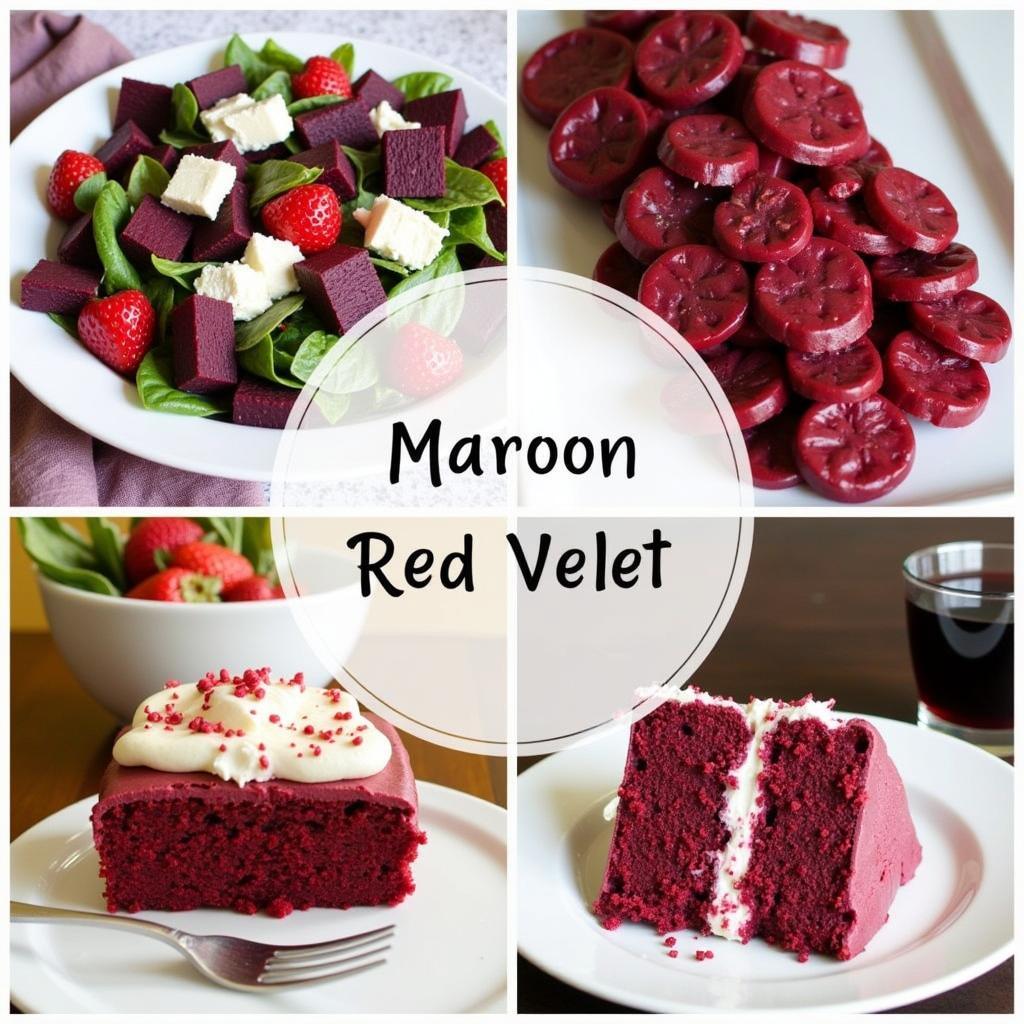Maroon Color Food evokes a sense of richness, luxury, and sophistication. From deep red wines and vibrant beetroots to decadent chocolate cakes, this captivating hue elevates culinary creations to a new level of visual appeal. Let’s delve into the fascinating world of maroon-colored foods, exploring their origins, nutritional benefits, and culinary applications.
The Origins of Maroon in Food
The maroon color in food often stems from natural pigments called anthocyanins. These powerful antioxidants are responsible for the vibrant hues found in many fruits and vegetables. The specific shade of maroon depends on the concentration and type of anthocyanins present, as well as other factors like pH levels and the presence of other pigments. For instance, the deep maroon of red wine comes from the anthocyanins extracted from grape skins during fermentation.
Nutritional Benefits of Maroon Foods
Foods rich in anthocyanins, the pigments responsible for the maroon color, offer a plethora of health benefits. These antioxidants help combat free radicals, protecting our cells from damage and reducing the risk of chronic diseases. Some studies have linked anthocyanin consumption to improved heart health, cognitive function, and even cancer prevention.
What are some examples of maroon-colored foods that are good for you?
Beets, red cabbage, and dark berries like blackberries and raspberries are excellent sources of anthocyanins and other beneficial nutrients. Incorporating these maroon-colored powerhouses into your diet can contribute to overall well-being. A simple beet salad or a handful of berries can make a significant difference.
Culinary Uses of Maroon Color Food
 Maroon Colored Dishes
Maroon Colored Dishes
Maroon’s versatility makes it a star ingredient in both sweet and savory dishes. It adds a touch of elegance to desserts like red velvet cake and a vibrant pop of color to salads and savory sides. You can achieve this rich hue naturally by incorporating ingredients like beets, red cabbage, or certain berries. maroon food coloring can also be used to enhance or create this color in various culinary applications.
How can I use maroon ingredients in my cooking?
Roasting beets brings out their natural sweetness, making them a delicious addition to salads or as a standalone side dish. Red cabbage adds a crunchy texture and vibrant color to slaws and stir-fries. And, of course, red wine is a staple in many sauces and braises, adding depth and complexity to the flavor profile. If you’re looking for a deeper shade, burgundy food coloring can be a great option.
Maroon Food Coloring: A Versatile Tool
While natural ingredients offer a healthy way to achieve the maroon color, red food colouring powder and powder red food coloring provide greater control and intensity, especially for baking and decorating. When using food coloring, always choose high-quality products and follow the instructions carefully.
“Maroon food coloring offers a fantastic way to achieve vibrant and consistent color in your culinary creations, especially when natural ingredients don’t quite provide the desired hue,” says renowned pastry chef, Amelia Dubois. “It’s a staple in my kitchen for creating stunning cakes and desserts.”
Maroon in Food Presentation
Food presentation plays a crucial role in enhancing the dining experience. The deep, rich tones of maroon can add a touch of sophistication and drama to any dish. Consider using maroon-colored plates or napkins to complement the food and create a visually appealing tablescape. Remember, even no food or drinks signs can be designed with a tasteful touch of maroon for specific areas.
“The use of color in food presentation can evoke a wide range of emotions and associations,” explains food stylist, David Chen. “Maroon, with its inherent richness, can create a sense of luxury and indulgence.”
In conclusion, maroon color food offers a delightful combination of visual appeal and potential health benefits. From naturally occurring pigments in fruits and vegetables to the versatility of food coloring, this captivating hue has a place in every kitchen. So, next time you’re looking to elevate your culinary creations, remember the allure of maroon.
FAQ
- What causes the maroon color in food?
- Are maroon-colored foods healthy?
- How can I incorporate maroon ingredients into my cooking?
- What are the benefits of using maroon food coloring?
- How can I use maroon in food presentation?
- What are some examples of maroon fruits and vegetables?
- Where can I buy quality maroon food coloring?
Need help? Contact us at Phone: 02437655121, Email: minacones@gmail.com Or visit us at: 3PGH+8R9, ĐT70A, thôn Trung, Bắc Từ Liêm, Hà Nội, Việt Nam. We have a 24/7 customer service team.